Why are there many shipping containers sizes in the market? It is because each of them has different features for various purposes. Nonetheless, each container size should follow international standards.
From the point of view of our freight forwarding expert, we helped companies with shipping container issues. So, you’ll learn the difference between various types of shipping containers. It will help you in choosing the proper storage containers for your need.
This post shares the differences between containers of different sizes. Let’s dive right in.
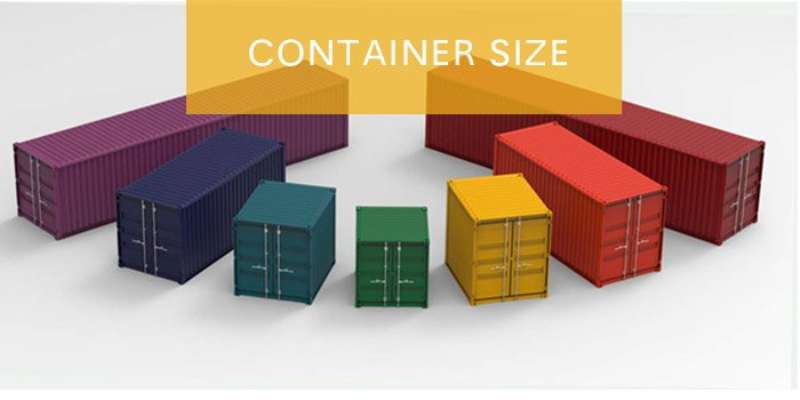
- The Basics About Container Dimensions
- Standard types of shipping container dimensions
- 1. 10-Foot Container
- 2. 20-foot Container
- 3. 20-foot High Cube Container
- 4. 40-foot Container
- 5. 40-foot High Cube Containers
- 6. 45-foot High Cube Container
- Other types of shipping container dimensions
- 1. 20-foot Flat Rack Shipping Container Dimensions
- 2. 40-foot Flat Rack Shipping Container Dimensions
- 3. 20-foot Open-top Shipping Container Dimensions
- 4. 40-foot Open-top Shipping Container Dimensions
- FAQs about Shipping Containers Sizes
- What’s Next
The Basics About Container Dimensions
What are External and Internal Dimensions?
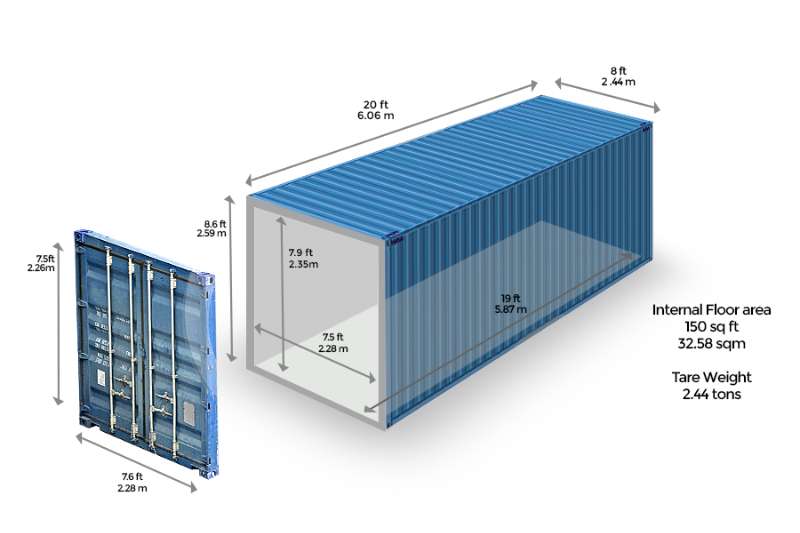
The external dimensions of a shipping container measure its length and width from the outside. It gives basic information about the size and storage of these shipping containers.
Internal dimensions are the dimensions of a container after reducing the container’s corrugation.
The depth of the corrugated steel is typically 1 inch from each left and right side. The corrugation on the shipping container cargo doors and back is usually 2 inches per side.
What do Maximum Gross Weights mean?
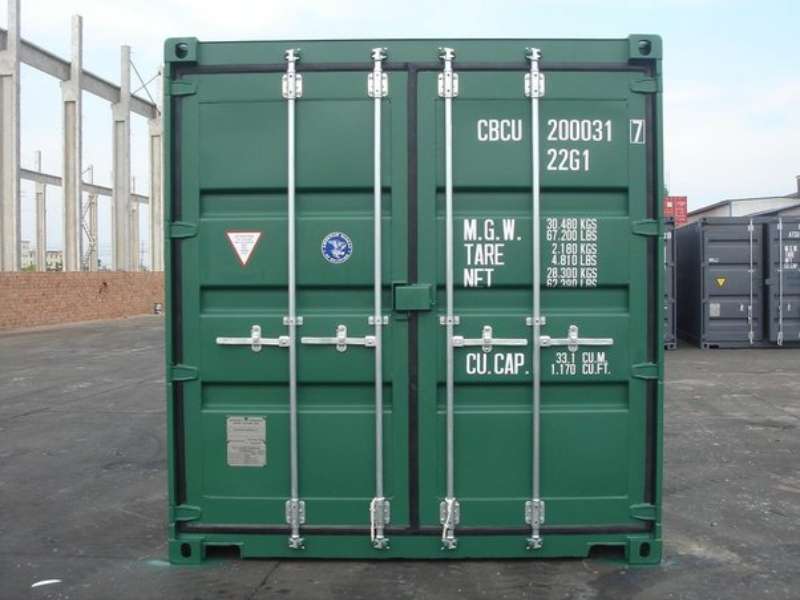
Max gross weights state how much weight the fully loaded ISO standard containers can carry. You can calculate it by this formula:
Max Gross Weight = Tare Weight + Payload Capacity
They normally follow two ISO standards: ISO 668 and ISO 1496. Therefore, shipping companies always need to ensure that the ISO containers meet these ISO requirements. Yet, it may vary slightly for different containers.
A Fast , Easy and Cheap Way to Ship from China
Do not hesitate to contact Leeline Sourcing at any time regarding your shipments from China.
What is Payload capacity?
Payload capacity is the maximum weight a shipping container can safely carry. It is also called the net weight or empty weight. You can calculate it using the formula below:
Payload Capacity = Max Gross Weights – Tare Weights/ Empty Weight
Ensuring that the payload capacity distributes evenly in the entire container’s floor area is crucial.
Suggested reading: 15 Most Common Types Of Containers
Standard types of shipping container dimensions
1. 10-Foot Container
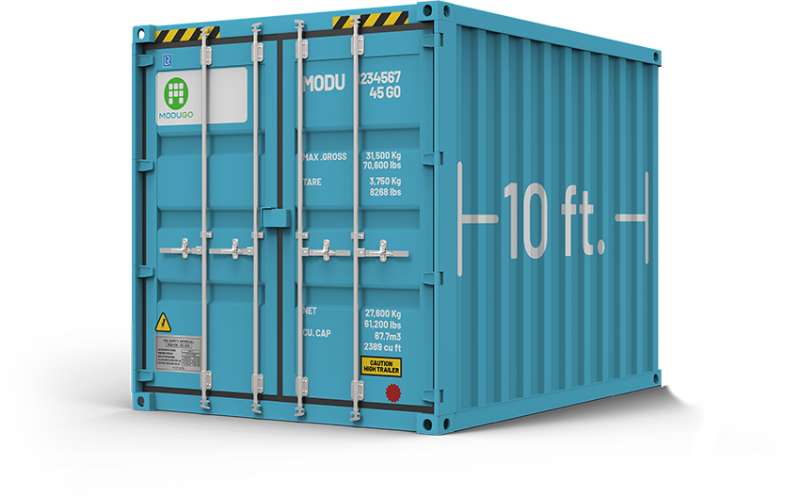
10-foot containers are helpful for various storage and modification purpose. Its size allows you to install it in different tight places. You can find those with walk-in, roll-up, and container doors for your need.
These containers are made of heavy-duty steel frames and are compact, secure, and mobile. You can use it for a professional and climate-controlled workspace. They are also aesthetic, cheaper, and modular.
Its common purpose is custom office containers, guard shacks, and commercial and residential secure storage. You can even use it for restrooms, breakrooms, and concession stands. Whether for long-term or short-term storage space, a 10-foot container is an ideal choice.
·External Dimension (LXWXH): 9’9.75″ x 8′ x 8’6″
·Internal Dimension (LXWXH): 9’3″ x 7’8″ x 7’10”
·Door Opening Dimension (WXH): 7’8″ x 7’5″
·Tare Weights: 2,645 lbs
·Payload capacity: 19,753 lbs
·Max Gross Weights: 22,398 lbs
2. 20-foot Container
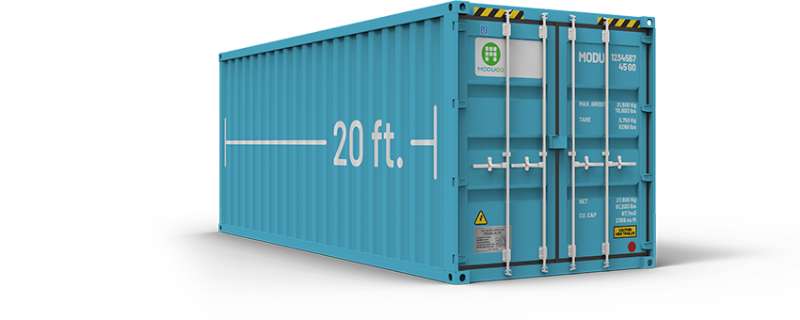
This cargo container is light-weighted, small, portable, affordable, and relocatable. Hence, it is easy for intermodal transport to move cargo without lifting equipment. You can also easily fit this container into many spaces based on your purpose.
20ft containers are helpful for the storage and transport of cargo. It can safely keep materials, vehicles, or construction tools, without weather element problems.
These containers are the most commonly used ISO shipping containers. People use it to transport heavy machinery and raw materials like rocks and iron ore. You can also use it for the construction, retail, and restaurant industries.
·External Dimension (LXWXH): 19’10.5″ x 8′ x 8’6″
·Internal Dimension (LXWXH): 19’3″ x 7’8″ x 7’10”
·Door Opening Dimension (WXH): 7’8″ x 7’5″
·Tare Weights: 4,850 lbs
·Payload capacity: 62,350 lbs
·Max Gross Weight: 67,200 lbs
3. 20-foot High Cube Container

These high cubes containers are 1 foot taller than the standard 20ft containers. They are wind-proof, water-proof, and sturdy. It has a high demand due to its extra height and space.
20ft high cube containers help transport bulky items that any other container cannot fit. Examples of goods are agricultural machinery, industrial materials, and construction equipment. As a result, you’ll be able to ship goods safely and efficiently globally using this container.
They have commonly used shipping containers for land and sea transportation, besides business or individual use. You can also use it to hold high-density goods, like dried gains, ceramics, and metal.
·External Dimension (LXWXH): 19’10.5″ x 8′ x 9’6″
·Internal Dimension (LXWXH): 19’3″ x 7’8″ x 8’10”
·Door Opening Dimension (WXH): 7’8″ x 8’5.5″
·Tare Weights: 5,103 lbs
·Payload capacity: 62,093 lbs
·Max Gross Weights: 67,196 lbs
4. 40-foot Container
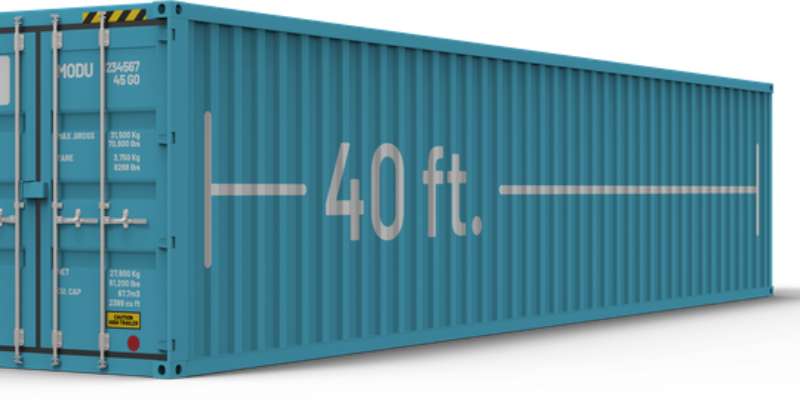
These containers are the largest containers among the standard-sized shipping containers. They are more efficient, economical, durable, sturdy, and watertight.
The 40ft containers are common in transporting larger amounts of light consumer goods. These goods include furniture, electronics, clothing, cotton, and vehicles. You can even use it for cafes, homes, shower blocks, ablution blocks, pop-up shops, and site offices.
However, carriers who carry overweight containers will be fined. Thus, these containers are widely used to transport large objects instead of heavy goods.
·External Dimension (LXWXH): 40′ x 8′ x 8’6″
·Internal Dimension (LXWXH): 39’5″ x 7’8″x 7’10”
·Door Opening Dimensions(WXH): 7’8″ x 7’5″
·Tare Weights: 8,380 lbs
·Payload capacity: 58,820 lbs
·Max Gross Weight: 67,200 lbs
5. 40-foot High Cube Containers
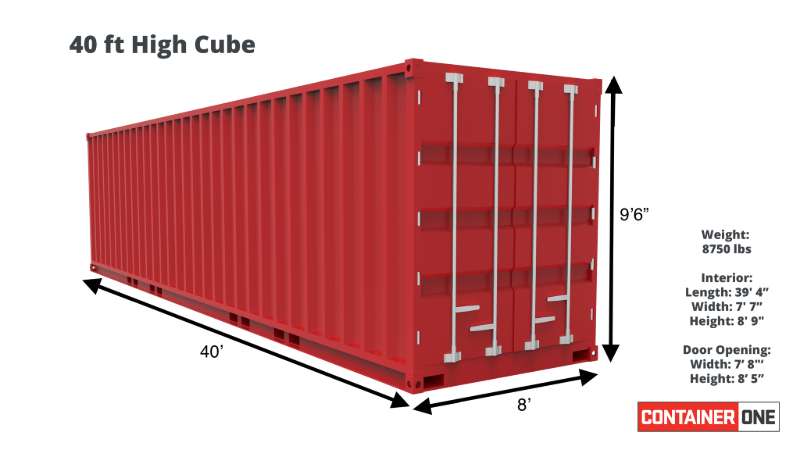
The 40ft high cube container is 1 foot taller than the 40ft standard container. Other than height, its specifications are similar to the 40-foot standard containers. It usually has several lashing rings that can bear loads of 1,000kg.
Like the 40ft containers, many carriers use them to move large volumes of light goods. For instance, clothing and furniture up to 8.1ft tall. You can use them to carry all types of general or dry cargo. But, they are more suitable for light, voluminous, and overheight cargoes.
·External Dimensions(LXWXH): 40′ x 8′ x 9’6″
·Internal Dimensions(LXWXH): 39’5″ x 7’8″x 8’10”
·Door Opening Dimensions(WXH): 7’8″ x 8’5.5″
·Tare Weights: 8,675 lbs
·Payload capacity: 58,522 lbs
·Max Gross Weights: 67,200 lbs
6. 45-foot High Cube Container
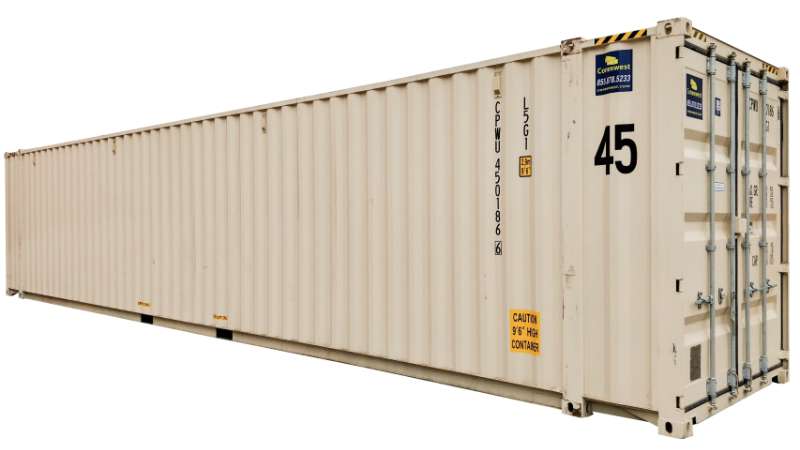
These containers are common containers for intermodal freight transportation. They are also famous for business purposes because of their durability and size.
It is ideal for transporting lightweight cargo as it has a larger maximum cubic capacity. People use it to transport light general cargo on the sea, whether above or under a rack.
It is also useful for land transportation, on the road or by rail. Many carriers use 45-foot high cube containers to carry heavy machinery and vehicles.
·External Dimensions(LXWXH): 45′ x 8′ x 9’6″
·Internal Dimensions(LXWXH): 44’5″ x 7’8″x 8’10”
·Door Opening Dimensions(WXH): 7’8″ x 8’5.5″
·Tare Weights: 10,000 lbs
·Payload capacity: 62,800 lbs
·Max Gross Weight: 73,000 lbs
Looking to find a reliable Chinese supplier?
As the best China sourcing agent, we help you find factories, get competitive prices, follow up production, ensure quality and deliver products to the door.
Other types of shipping container dimensions
1. 20-foot Flat Rack Shipping Container Dimensions
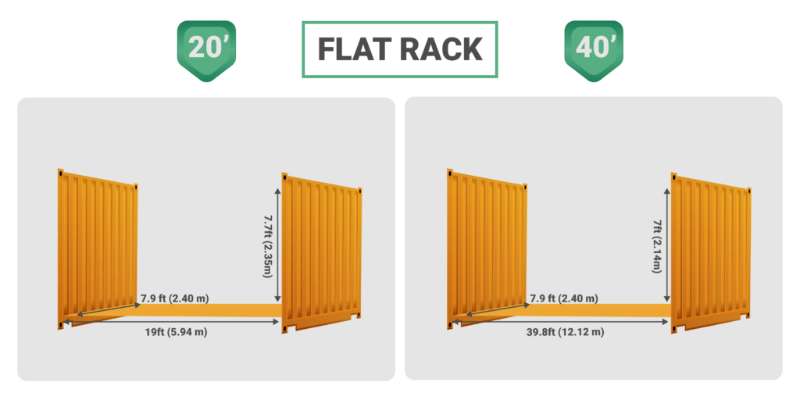
The 20ft flat rack container is a storage container with no roof or sidewalls. They have fixed walls or folding ends to store heavy loads. The carriers usually fix the cargo on the flat racks using chains and belts.
These containers are common for bulky, oversized, extra-wide, or unique-shaped cargo transportation. In addition, they are practical for goods like vehicles and boats that cannot fit in other containers.
You can easily store these flat-rack containers due to their collapsible or fixed ends. It allows adjustment to fit longer items or easy storage when you’re not using it. Remember to use steel flooring instead of wood flooring for extreme weight.
·Exterior Dimensions (LXWXH): 19’1” x 7’1” x 8’6”
·Interior Dimensions (LXWXH): 18’4” x 7’11” x 7’3”
·Tare Weights: 6,040 lbs
·Payload capacity: 68,916 lbs
·Max Gross Weights: 74,957 lbs
2. 40-foot Flat Rack Shipping Container Dimensions
These containers are similar to 20ft flat rack shipping containers. They have fixed walls or folding ends for storage and transportation of heavy loads.
40ft flat rack shipping containers are helpful for shipping out-of-gauge (OOG) cargo. These cargoes are typically too large for 20- or 40ft storage container transportation. An example of such goods is bundled pipe. As a result, you’ll be able to save more time and money in shipping your goods.
The 40ft flat rack containers have tightening rings for easier adjustments. You must check these containers carefully before delivery. Ensure they have a valid CSC date and comply with international quality standards.
·External Dimension (LXWXH): 40′ x 7’11” x 8’6”
·Internal Dimension (LXWXH): 39’5” x 7’8” x 7’1”
·Tare Weights: 9,259 lbs
·Payload capacity: 89,848 lbs
·Max Gross Weights: 67,196 lbs
3. 20-foot Open-top Shipping Container Dimensions
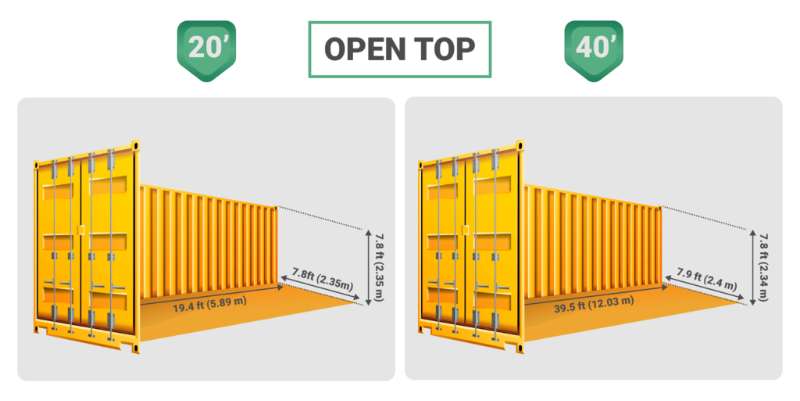
20ft open-top shipping containers help carry over-height and dense goods. They are versatile, flexible, and safe to load goods from the top and rear. The header rail at the door and the roof is easily removable for easy loading. It also has low tare weights that allow a higher maximum payload.
These containers are Corten Steel and heavy-duty tarpaulin for extra cargo protection. They also have removable steel bars and a TIR cable to fasten the tarpaulin. You can use it to transport oversized goods by road, rail, or sea.
·External Dimension (LXWXH): 20′ x 8′ x 8′
·Internal Dimension (LXWXH): 19’3” x 7’8” x 7’7”
·Door Opening Dimension (WXH): 7’8” x 7’6”
·Tare Weights: 4,740 lbs
·Payload capacity: 62,460 lbs
·Max Gross Weights: 67,200 lbs
4. 40-foot Open-top Shipping Container Dimensions
A 40-ft open-top shipping container can carry lightweight, over-height, and bulk cargo. It has a heavy-duty floor that can sustain the floor strength test of 15,873 lbs.
Similar to a 20ft open-top shipping container, they are also made of Corten Steel and heavy-duty tarpaulin. The 40ft open-top shipping container is advantageous for freight use. You can remove the cover to allow top loading of over-height goods.
Carriers typically use cranes or crabs to pack and unpack cargo to open-top containers quickly. For example, timber, steel, machinery, scrap metals, etc.
·External Dimension (LXWXH): 40′ x 8′ x 8’6”
·Internal Dimension (LXWXH): 39’6” x 7’9” x 7’8”
·Door Opening Dimension (WXH): 7’8” x 7’6”
·Tare Weights: 8,050 lbs
·Payload capacity: 63,600 lbs
·Max Gross Weights: 71,650 lbs
FAQs about Shipping Containers Sizes
1. Are shipping containers bulletproof?
No, shipping containers are neither bulletproof, even though some can stop bullets. But they can sustain a decent amount of wear and tear. There were some cases where bullets hit shipping containers, but they managed to survive.
2. Why are shipping container sizes standardized?
All types of shipping containers must comply with international organization standards like ISO or CSC. It is because these containers are mass-produced for a severe marine environment. Standardized shipping containers allow more consistent loading, transportation, and unloading.
3. How much does a 40-foot shipping container cost?
A 40ft shipping container typically costs $4,000 to $8,300, whereas a 40ft high cube container costs around $5,500. You can check them with the container manufacturers.
The final price depends on the container’s type conditions and your location. The types include tank containers, refrigerated containers, and insulated containers.
What’s Next
As previously discussed, the features and purposes of every single container are different. You should choose the correct container sizes, whether open-side containers or Intermodal containers. Suitable storage containers can help you save time and cost in shipping.
Are you looking for general-purpose containers or other container sizes? Leeline Sourcing has over ten years of experience in freight forwarding. Drop us a message today for a comprehensive shipping solution.








